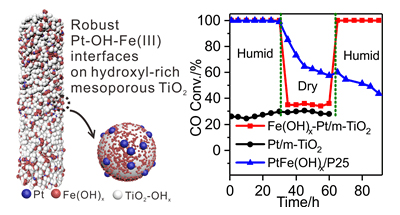| [1] Wu, B. H.; Zheng, N. F. Nano Today 2013, 8, 168.
[2] Gong, J. L.; Bao, X. H. Chem. Soc. Rev. 2017, 46, 1770.
[3] Rodriguez, J. A.; Ma, S.; Liu, P.; Hrbek, J.; Evans, J.; Perez, M. Science 2007, 318, 1757.
[4] Fu, Q.; Saltsburg, H.; Flytzani-Stephanopoulos, M. Science 2003, 301, 935.
[5] Jia, Q.; Ghoshal, S.; Li, J.; Liang, W.; Meng, G.; Che, H.; Zhang, S.; Ma, Z. F.; Mukerjee, S. J. Am. Chem. Soc. 2017, 139, 7893.
[6] Graciani, J.; Mudiyanselage, K.; Xu, F.; Baber, A. E.; Evans, J.; Senanayake, S. D.; Stacchiola, D. J.; Liu, P.; Hrbek, J.; Fernandez Sanz, J.; Rodriguez, J. A. Science 2014, 345, 546.
[7] Kuld, S.; Thorhauge, M.; Falsig, H.; Elkjaer, C. F.; Helveg, S.; Chorkendorff, I.; Sehested, J. Science 2016, 352, 969.
[8] Behrens, M.; Studt, F.; Kasatkin, I.; Kuhl, S.; Havecker, M.; Abild-Pedersen, F.; Zander, S.; Girgsdies, F.; Kurr, P.; Kniep, B. L.; Tovar, M.; Fischer, R. W.; Norskov, J. K.; Schlogl, R. Science 2012, 336, 893.
[9] Guan, H.; Lin, J.; Qiao, B.; Yang, X.; Li, L.; Miao, S.; Liu, J.; Wang, A.; Wang, X.; Zhang, T. Angew. Chem. Int. Ed. 2016, 55, 2820.
[10] Guan, H. L.; Lin, J.; Li, L.; Wang, X. D.; Zhang, T. Appl. Catal. B-Environ. 2016, 184, 299.
[11] Lin, J.; Wang, X. D.; Zhang, T. Chinese J. Catal. 2016, 37, 1805.
[12] Cargnello, M.; Doan-Nguyen, V. V.; Gordon, T. R.; Diaz, R. E.; Stach, E. A.; Gorte, R. J.; Fornasiero, P.; Murray, C. B. Science 2013, 341, 771.
[13] Green, I. X.; Tang, W.; Neurock, M.; Yates, J. T., Jr. Science 2011, 333, 736.
[14] Wang, Y. G.; Cantu, D. C.; Lee, M. S.; Li, J.; Glezakou, V. A.; Rousseau, R. J. Am. Chem. Soc. 2016, 138, 10467.
[15] Qin, R.; Liu, P.; Fu, G.; Zheng, N. Small Methods 2018, 2, 1700286.
[16] Tauster, S. J. Acc. Chem. Res. 2002, 20, 389.
[17] Chen, G.; Zhao, Y.; Fu, G.; Duchesne, P. N.; Gu, L.; Zheng, Y.; Weng, X.; Chen, M.; Zhang, P.; Pao, C. W.; Lee, J. F.; Zheng, N. Science 2014, 344, 495.
[18] Jiang, X. C.; Wang, Y. L.; Herricks, T.; Xia, Y. N. J. Mater. Chem. 2004, 14, 695.
[19] Liu, P.; Zhao, Y.; Qin, R.; Mo, S.; Chen, G.; Gu, L.; Chevrier, D. M.; Zhang, P.; Guo, Q.; Zang, D.; Wu, B.; Fu, G.; Zheng, N. Science 2016, 352, 797.
[20] Liu, P.; Chen, J.; Zheng, N. Chinese J. Catal. 2017, 38, 1574.
[21] Yang, M.; Allard, L. F.; Flytzani-Stephanopoulos, M. J. Am. Chem. Soc. 2013, 135, 3768.
[22] Kydd, R.; Scott, J.; Teoh, W. Y.; Chiang, K.; Amal, R. Langmuir 2010, 26, 2099.
[23] Chen, S. F.; Li, J. P.; Qian, K.; Xu, W. P.; Lu, Y.; Huang, W. X.; Yu, S. H. Nano Res. 2010, 3, 244.
[24] Bamwenda, G. R.; Tsubota, S.; Nakamura, T.; Haruta, M. Catal. Lett. 1997, 44, 83.
[25] Zhang, Q.; Li, R. G.; Li, Z.; Li, A. L.; Wang, S. Y.; Liang, Z. X.; Liao, S. J.; Li, C. J. Catal. 2016, 337, 36.
[26] Lahiri, D.; Subramanian, V.; Shibata, T.; Wolf, E. E.; Bunker, B. A.; Kamat, P. V. J. Appl. Phys. 2003, 93, 2575.
[27] Chen, G.; Yang, H.; Wu, B.; Zheng, Y.; Zheng, N. Dalton Trans. 2013, 42, 12699.
[28] Lin, J.; Qiao, B. T.; Li, L.; Guan, H. L.; Ruan, C. Y.; Wang, A. Q.; Zhang, W. S.; Wang, X. D.; Zhang, T. J. Catal. 2014, 319, 142.
[29] Xu, L.; Ma, Y.; Zhang, Y.; Jiang, Z.; Huang, W. J. Am. Chem. Soc. 2009, 131, 16366.
[30] Prins, R. Chem. Rev. 2012, 112, 2714. |
